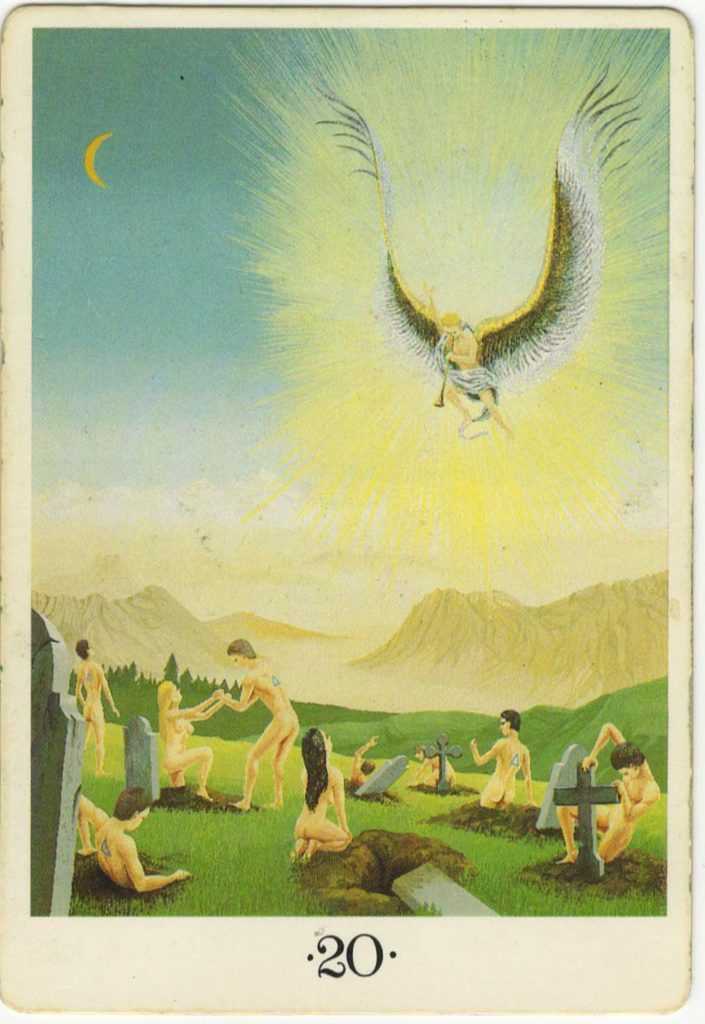
resurrection
The penultimate card of the tarot from the Marseille tradition is often called Judgement, and has within its symbolism people emerging from their graves resurrected at the call of Gabriel’s angelic horn.
In the deck that initially inspired this work, The Tarot of Frown Strong, the card was actually called The Resurrection, but has very similar imagery.
I’ll start with a clear position; I don’t believe there to be a “Judgement Day” or “Final Judgement”. There is no Saint Peter with a record of our misdemeanours, any more than there is an Anubis who weighs our heart with a feather of Maat.
I’m still interested in the notion of a divine judgement though.
In the three Abrahamic religions Judgement Day exists as you might expect. They’re quite different in their understanding of it. In Islam the Judgement Day- Yawm al-Din – looks remarkably similar to the Judgement Card of the tarot. Gabriel is named Israfil, but it is ostensibly the same entity. Here though the judgement comes AFTER the resurrection. Everyone rises naked from the grave, saints and sinners, Muslims, athiests and apostates alike. They’re given a Book of Deeds filled with all of their life’s actions and intentions, and the good deeds and bad deeds weighed against each other. Whether they get a pleasant afterlife or etenity in the abyss is decided solely by the balance. The intentions bit is important so I’ll come back to it.
Christianity has a varied and evolving understanding of a final judgement. In much of catholicism one’s salvation is “through the Lord Jesus”, so to them only Christians will get a favourable judgement. In the more extreme versions even babies unbaptised or born out of wedlock are condemned. The Roman Catholic mother and baby home in Tuam is testament to that, where 800 infants and babies were allowed to die with no last rites given and their bodies hidden in an unconsecrated makeshift mausoleum. Even the most heinous of sins can be absolved by a priest, and it seems forgiven by God on Judgement, as long as the sinner came to Jesus and repented before death. There are less extreme views of Final Judgement within Christianity of course, but generally “Through Me is the Way” is a fixed cornerstone.
Judaism has a Day of Atonement each year. Yom Kippur is the day on which God decides the fate of everyone over the coming year, so it is important for Jews to atone for the sins (and for the Rabbis to ask God for forgiveness for everyone’s sins) in the run up to that day.
Many other religions from antiquity to the present day have a similar end of life event in which we are judged by an exraordinary being or deity.
There is no God that decides our fate within The Fools’ Journey. To use a fitting travel analogy, if we haven’t maintained the car and put sufficient fuel in it to get us to the destination, then it doesn’t get there. Us not arriving isn’t a divine judgement; God isn’t punishing us for the sin of not knowing a diesel pump from an unleaded pump, it is simply the natural laws in action. IF there is a continuation beyond this physical existence, and IF certain cosmic criteria must be met to facilitate it, then the individual simply meets or doesn’t meet the criteria.
Judgement in relation to the Fools’ Journey
There are two key points where we can focus on the criteria for elevation along the Journey. Where the octaves complete- between the 7 and 8, and again between the 14 and 15- are places where this SELF assessment perhaps has its strongest influence, but they are still parts of a continuous journey upon which we take stock throughout.
The twentieth tabloid of The Fools’ Journey is The Chamber. Although some of its symbolism mirrors (or at least hints at) that of the Judgement card, there is no judgement. There is procession dependant on met criteria.
